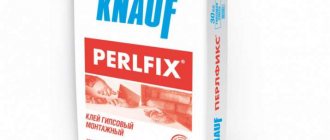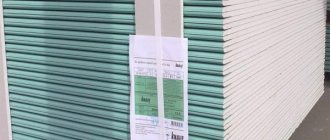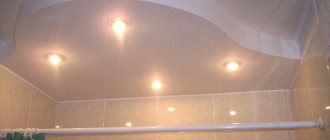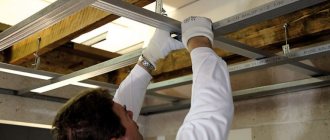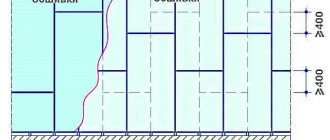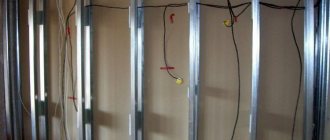Peculiarities
Working with KNAUF plasterboard sheets is practically no different from installing other gypsum boards. However, the manufacturer produces the necessary components to create a plasterboard surface. All materials assembled into a set for wall cladding are called a system. This simplifies the work because all components are made for each other. There is no need to think about installing non-standard additional elements.
Pros of using technology
The KNAUF complex includes all the necessary elements for cladding a wall or creating a partition. This has advantages:
- the use of high quality materials, which guarantees a long service life;
- ease of calculation of the necessary materials for installation;
- KNAUF kit includes detailed assembly instructions;
- If you purchase gypsum boards and components separately, some small details are often forgotten. Everything is included in the kit.
Each structure has its own purpose: ordinary partitions, double cladding, and so on.
Types of plasterboards used in KNAUF systems
The gypsum plasterboard kit for wall cladding has the following types of sheets:
- Gray plasterboard – thickness from 9.5 mm. used in rooms with moderate humidity.
- Green moisture-resistant sheet - systems with such sheets are used in wet rooms.
- Green with red inscription, combined - a combination of moisture-resistant and fire-resistant materials.
Wall cladding systems are carried out using 2 methods: frame (metal lathing from profiles) and frameless (gluing sheets to an adhesive composition).
Profile for plasterboard wall. What are the types and sizes of Knauf profiles for drywall?
The company “Standard Resource” creates favorable prices for the Knauf profile . Customers have the opportunity to purchase all components with delivery to any facility in the region.
The Knauf metal profile is intended for constructing various types of frames and subsequent fastening of plasterboard sheets to them. Using the systems, ceilings are equipped, niches, prefabricated partitions, and cladding are formed. Frames based on the Knauf profile are distinguished by their rigidity and strength. Elements are made from thin steel strip, 0.6 mm thick, by processing on roll forming equipment.
They produce products of standard length - 3; 3.5 and 4 meters, in some cases other sizes can be prepared upon request. The rigidity of Knauf elements is achieved through longitudinal corrugations, and special galvanizing treatment ensures resistance to aggressive external factors. The zinc coating of Knauf profiles can only be destroyed under the influence of concentrated acid. Cutting and assembling products is carried out using ordinary tools; there is no need to provide additional corrosion protection at the cut points.
Knauf installation technology: drywall, walls and partitions
Knauf installation technology is not much different from the generally accepted work on wall cladding and creating partitions.
When assembling the structure, you must adhere to some rules:
- plasterboard sheets are fixed to a metal or wooden frame from the center or from the corner. This is done so that the fox does not become deformed. For fixation, use NK 11 screws.
- To create a strong joint between the sheets, they are mounted close to each other, without leaving a gap.
- GKL is mounted so that there are no cross-shaped seams. Sheets on the surface must be shifted.
- To use the frameless method, you need to choose 12.5 mm sheets.
- To glue the sheets, use PERLFIX glue. After gluing, the master has 10 minutes to level the sheet on the surface.
- When laying thermal insulation material for attaching gypsum boards to the frame base, the kit includes 35 mm screws for a wooden base and 25 mm screws for metal profiles.
- The KNAUF profile is cut with metal scissors.
- Before fixing, soundproofing tape is applied to the guide profiles.
- For good sound insulation, you need to retreat at least 50 mm from the rough wall to the guide.
- If a Knauf system partition is created, with a room height of 2.80 m, the door leaf should be 90 cm wide and weigh up to 25 kg.
Scope of application of the Knauf plasterboard profile
Sheathing work, as a rule, involves constructing a frame from Knauf components with a ventilation or technological gap for utilities, insulation for a summer house or sound insulation in an apartment. This approach also makes it possible to level the plane and create original structural forms in an accelerated manner without the use of water-containing building materials.
Profiles
To implement such projects, it is first necessary to assemble the sheathing. It will serve as a supporting base for new walls, ceilings or floors. This frame is assembled from wooden beams or metal profiles. For interior work, the best option is a plasterboard metal profile made of galvanized steel. It is rarely used outside due to its thin anti-corrosion protection.
Important! Knauf aluminum products have better characteristics, have a longer service life and are less susceptible to changes in humidity, therefore they are allowed for finishing facades.
On what surfaces is cladding acceptable?
The Knauf design is applicable in various areas: walls, ceilings, floors.
Frameless method applicable for concrete and brick walls. When installing the system using this method, you need to choose the right primer.
The frame method is used if the room is damp, the walls tend to become damp, and there is a desire to improve sound and thermal insulation with the help of additional material.
- There are kits for creating suspended ceilings;
- kits for working in the attic - fastening from the rafters.
KNAUF plasterboard kits are mounted on various surfaces. Each of which has its own requirements and compliance with certain rules.
How effective is Knauf drywall/walls/partitions technology: heat consumption standards
Knauf kits use heat and soundproofing materials in accordance with GOST 9573-96, 21880-94, 10499-95, as well as materials included in the “List of polymer materials and structures approved for use in construction by the USSR Ministry of Health” - M. 1985. Having a conclusion on compliance with sanitary standards of the Legislation of the Russian Federation.
To maintain indoor heat consumption standards, KNAUF systems have materials that are calculated individually for each case (dry but cold rooms, wet rooms).
The thermal insulation layer is placed only in the frame base. It is impossible to use insulation in the frameless method.
Installation of Knauf drywall - from selection of materials to installation
The German company Knauf has long been considered a European and world construction standard, and the set of measures, which in our country is called European-quality renovation, is based on the achievements, materials and technologies obtained thanks to the developments of this particular company.
Without going too much into historical digressions and amendments, just for the sake of interest, I would like to note that this company, which began as a family business in Bavaria, represents its products in almost 40 countries around the world. And the total number of enterprises of this corporation of “monsters” (in a good and business context) has long crossed the 200 mark. Now let’s leave the historical and statistical calculations and move on to more practical things - technology.
Drywall from Knauf is the business card of the concern.
Basic principles of technology and policy
Work training – Knauf style.
Thanks to its principles, mixed with German quality, the company quickly became a leader: it is considered and its opinion is listened to all over the world. It is not for nothing that Knauf has practically no full-fledged competitors on the world market.
This success is based on two basic principles:
- Offer consumers only proven and high-quality materials;
- Carry out the repair and construction process strictly in accordance with the stated technologies. For this purpose, training of plasterboard masters is carried out on the basis of specially created training centers.
The company meticulously pays attention to all the details. Considering that they cannot exist as such, everything is important.
Let's start with the basics
The installation instructions for Knauf drywall begin with coverage of the selection of materials and tools. It is clear that the company tried to declare its products, but as they say, it has the right to do so.
So, Knauf offers and recommends:
- There are four main types of plasterboard sheets:
- Ordinary plasterboard sheets are intended for interior decoration of premises for which no special requirements are imposed: living rooms, studies, offices;
- Moisture-resistant plasterboard sheet , which is suitable for bathrooms, kitchens and other interior spaces where there is high humidity;
- or special plasterboard
- Combined fire and moisture resistant sheet . No additional explanation or introduction is needed.
In this case, moisture resistant.
For your information! For the convenience of sellers and buyers, each sheet of drywall has its own color and markings. In domestic use, the most popular and frequently purchased are ordinary plasterboard sheets and moisture-resistant plasterboard sheets, sheet thickness 12.5 mm for walls, and 9 mm for ceilings
- Metal profiles. Their purpose is to construct a frame on a ceiling or wall in order to install plasterboard sheets in one plane. At the same time, it is allowed, and sometimes encouraged, to create multi-level structures on the ceiling according to individual projects, as well as the construction of built-in furniture, niches, supporting or zoning structures. Here, too, the leading profiles are of four types:
- Ceiling CD profile is used to create lathing on the ceiling;
- A guide ceiling UD profile, a profile with the help of which a single (basic) level is established for the entire ceiling structure, is placed along the perimeter of the walls as close as possible to the ceiling (if it does not concern raster variations, with a deliberate reduction in the ceiling level);
- Rack-mounted CW profile, similar to the ceiling CD. It is from this that the frame of the wall sheathing is formed, and it also takes an active part in the creation of built-in niches, false walls, and partitions;
- Guide for CW profile UW profile. Analogue of UD for use in wall structures, the directions of application are the same as for CW.
- Connecting and extension elements, mounting options:
- The suspension is straight, universal, and difficult to replace, 120 mm. This is a really worthwhile invention, designed for attaching profiles to stationary walls and ceilings, installation is done with metal screws, the protruding parts are bent inward. By the way, the suspension is the leader in the number of popular names;
- Extension of ceiling profiles CD-60. The main purpose is to cover the entire length of the room.
For your information! The Knauf drywall installation technology involves the use of exclusively “native” parts described in this subsection.
Well, we inform lovers of pure experiments that, of course, technologies exist and they must be followed. And for practitioners, everything described in this paragraph can be perfectly replaced with fragments of the UD-27 profile. The only thing that will be technologically more difficult to replace is direct suspension.
- Single-level crab connector, cross connection for CD ceiling profiles. In this design, the overlay occurs on the main CD profile, and the side profiles are represented by trimmings of the required length;
The ceiling lathing is a crab mounting element.
- Two-level ceiling connecting element. The purpose of this design is to join the sheathing parts when approaching the profile near a natural obstacle. T-joint;
- Suspension for raster and suspended structures is designed to significantly lower the ceiling level. Gift raster designs. One suspension can support up to 25 kg of ceiling weight.
- Putties and primers. Everything is simple here, despite the variety of specimens presented, they can all be grouped. And then we get the following:
- Putty for joints based on alpha gypsum, with or without additives;
Design and types of profiles
In cross section, profiles for gypsum boards are U-shaped.
U-shape
*
Depending on the purpose, the edges can be rolled to give the products additional bending strength. All plasterboard profiles, with the exception of the corner-forming one, are divided into 2 groups:
- The rack profile is characterized by high rigidity with longitudinal edges rounded inward. The products are intended to create a basis for fastening cladding materials.
- The ceiling guide profile may not have additional fins. It serves to provide support for the sheathing. Products are attached directly to walls, floors and ceilings along the entire perimeter of the frame.
Racks and guides are made in pairs. The height of the first always corresponds to the width of the second profile element to ensure a tight nodal connection. The products are additionally fastened together with galvanized metal screws (bugs).
Separately, we consider a corner element with perforation or notch, which is designed to cover drywall cuts, form corners, and give them rigidity during plastering work. Made from steel, aluminum and plastic.
Corner element with perforation
The beacon profile is used to pull the tie through the rule. Additionally, a fiberglass mesh can be attached to reinforce the leveling layer.
What are the requirements for the frame within the technology
The Knauf company focuses on several important nuances that need to be taken into account when assembling a frame for a suspended ceiling using its technology. These include:
- the use of plasterboard sheets produced by the company with a high level of protection against moisture;
- installation of profiles in order to avoid deformation of the ceiling under the influence of the mass of finishing material is carried out in a checkerboard pattern with an overlap or staggered;
- Knauf fastening elements are used for connection;
- to prevent deformation of the coating under the influence of vibrations that occur when the door is regularly opened, avoid joining sheets in the center of the opening;
- the finished frame must be finished with thermal insulation tape.
With your own hands, a gypsum board ceiling using Knauf technology is assembled from special profiles marked UD and CD.
Advantages of Knauf products
The company pays special attention to quality and uses 0.6 mm thick metal so that the element has sufficient rigidity. Compliance with the requirements for this parameter guarantees the strength of the gypsum board fastening to the frame, since the screws are firmly held in the metal. All steel is galvanized to prevent corrosion and increase service life.
Also distinctive features of the Knauf plasterboard profile are:
- stiffening rib;
- holes for fasteners, wires and other communications;
- markings for ease of installation;
- special geometry that facilitates the connection of elements.
Depending on the design of the frame, its thickness and power, the manufacturer’s catalog presents several types of profiles with different sizes. In order to build a wall or other structure, you will definitely need guides and rack types. The guides are attached to a solid base: the walls, floor or ceiling of the room being repaired. Rack-mounted ones are secured to the created frame with the help of grips using self-tapping screws with a press washer or other fasteners. For the construction of suspended ceilings, the Knauf company produces certain types of products. These elements have a different shape from the wall ones for greater strength.
Advantages of technology: why it is used
Properly planned and installed plasterboard structures can not only complement the interior, but also add the necessary accents, adjust the size of the room, and hide communications and electrical wiring. Ceiling installation using Knauf technology allows you to create practical designer ceilings with minimal effort and time. The finished design opens up more opportunities for experimenting with light and demonstrates excellent thermal and sound insulation performance.
Installation of ceilings is carried out from the materials included in the kit. It includes sheets of plasterboard from the manufacturer with optimal dimensions and properties, and a metal frame. Working with such a set is convenient even for a beginner.
Differences between the Knauf ceiling profile and other models and advantages of use
A suspended ceiling made of plasterboard using Knauf technology stands out from the product line with a significant list of advantages and features:
- Allows you to correct too high room heights. This is achieved by installing the profile system at the required level.
- Hides all utility lines running in the upper part of the wall, regardless of their size, as well as plane defects and protruding elements in the form of beams, purlins, crossbars or building trusses.
- A wide range of finishing options will help bring different design ideas to life.
- It is convenient to place built-in, hanging or hidden lamps into the system.
- The space between the suspended and base surfaces is sufficient for laying out insulating and insulating materials.
- The design is carried out in different versions - single-level, multi-level, with the design of figured, curved cladding.
- The system of profiles and plasterboard parts is suitable for rapid redevelopment of premises.
An important advantage is the speed of assembly of the kit. The elements are fitted with perfect precision, so the work takes a minimum of time.
Read with this
- Required profile for a plasterboard partition: 3 types
- Types of profiles for drywall: dimensions and purpose
- How to attach drywall to a wall: 2 installation methods
- Plasterboard structures and their use in modern interiors
- Are MDF panels suitable for ceilings?
- Corrugated sheet
- Profiles for suspended ceilings: types, installation methods
- Using a drywall lift and creating a structure with your own hands
- Drywall crab: pros and cons
- Suspended plasterboard ceilings: features and advantages
Preparation for installation of the structure
Installing a Knauf plasterboard ceiling is permitted only after completion of construction and finishing work associated with wet processes. In addition, by this time the walls should be leveled and finished.
It is allowed to begin the process of installing a ceiling structure provided that the temperature and humidity conditions are observed. It is important that the temperature is not lower than 10 degrees Celsius, and the humidity does not exceed 60%.
The beginning of the work must necessarily be the correct calculation of the ceiling, drawing up a design project, and carrying out markings. At the same stage, the functionality of ventilation, electrical and other communications is checked.
DIY frame: useful recommendations from the authors of the technology
Using a level for control and a tapping thread, mark a line on the walls around the perimeter of the room. Taking into account the type of drywall chosen for installation, mark the guides with points for mounting the hangers.
Suspensions are secured with anchors or dowels in the marked areas. Further work will depend on the choice of a wooden or metal frame.
So, the technology for installing Knauf plasterboard on a ceiling using a wooden frame involves the following algorithm:
- The beam is attached to the base using a direct or quickly mounted suspension. The second option will allow you to instantly change the mounting side.
- Fix the guide beam on the ceiling surface using pads to reduce differences in the height of the base.
Some features of installing a metal frame:
- The profiles are connected with hangers, not forgetting about the expansion gap of 10 mm (this will protect the structure during temperature changes).
- Use sealing tape to lay under the guide profile.
- Only a wall profile is used; solid guides are attached along a long wall. The dowel fastening spacing is up to 30 cm, the supporting profile must fit into the guide by at least 3 cm.
The finished frame is sheathed with Knauf plasterboard sheets, again observing some nuances.
Installation of profiles for Knauf drywall
*
Corner-forming and beacon profiles are installed more often using a leveling mixture. Otherwise, all drywall components are fixed with self-tapping screws. To fasten rack and guide profiles to walls, hardware with dowels or anchor bolts are used. To do this, manufacturers often drill holes with a diameter of 6-8 mm at a distance provided by the technology for installing plasterboard profiles. The recommended pitch is 20 cm.
The step-by-step installation of a frame for drywall is as follows:
- Markings are applied under the guides, taking into account the plane of the skin and the distance required for laying utilities, mineral wool, and sound insulation.
- The PN is fixed with an overlap. It bends at the corners after cutting the ribs. For rigidity, the edges are additionally fastened together with self-tapping screws. The pitch of the main fasteners is 20-50 cm.
- The racks are inserted into the guide and secured with “bugs”. The distance between them is 60 cm based on the standard dimensions of a Knauf plasterboard sheet. For the ceiling, the lathing is assembled in cellular form with the same pitch. Connecting components are used to strengthen the frame.
Profile installation
To regulate the distance between all parts of the supporting structure and the base, limiters are additionally installed. These can be profile “boots”, straight or corner hangers. The number of parts depends on the weight of the skin and the load that will be placed on it. Additionally, jumpers made of rack profiles are installed under attachments and equipment. A wooden beam or reinforced metal profile can also be used.
Finishing gypsum board ceilings - what you need to know
When installing a ceiling using Knauf technology, you must adhere to the main rule: the sheets are fixed across the supporting profile with screws at right angles. Before installation, the sheets must be processed in the area of the edge not covered with cardboard to remove the chamfer.
Installation of sheets is carried out with an assistant or using a special lifting mechanism. The sheets are fastened without joints, as already noted, in a checkerboard pattern or staggered. It is correct that the sheet be laid in the longitudinal direction without a gap, while in the transverse direction a small gap would form. Only in this case will it be possible to putty the joint in such a way as to obtain a perfectly even seam.
It must be taken into account that temperature changes will affect the plasterboard surface of the ceiling - the sheets will expand and slightly deform. To avoid serious deformations, special expansion joints are installed in increments of 15 m.
To prevent the self-tapping screws from spoiling the finish coating with the released caps, they are screwed in with a slight immersion into the sheet to a depth of no more than 1 mm. The joints are sealed with reinforcing tape.
Tools for working with wireframe elements
The basic set includes several basic tools.
- Screwdriver. With its help, a huge amount of work is carried out; it is involved in many processes. Therefore, you need to choose this important tool consciously. A cordless screwdriver is more suitable for “home” craftsmen, while a corded screwdriver is more suitable for professional use over large areas. The latter has a special tape-type attachment, which makes working with self-tapping screws easier.
- Hammer . It will be needed if the base is concrete or brick. It is used to make round holes for dowels that secure the profile to the base.
- To cut metal elements, it is recommended to use a saw . But if the amount of work is small, use metal scissors or a hacksaw with a fine tooth. It is important to have several types of cutting tools in your arsenal (for example, for large and small notches).
- Profile cutter. With its help it is convenient to make even holes in metal. Making a steel frame is much faster this way.
- Special pliers. Their use is possible where the screwdriver does not pass or does not reach the profile. The pliers connect the steel elements. In this case, additional fasteners are not needed.
- Laser or regular building level with a bubble inside . A modern laser measuring device is, of course, more convenient, but also more expensive than a conventional one.
- Roulette with limiter . It is more convenient to use tape measures 5 m and 7.5 m long.
Finishing - stages of implementation
When designing and installing two-level ceilings in accordance with the described technology, it is recommended to increase the strength of the material through the use of finishes based on water-repellent compounds and putty mixtures.
The seams are masked using the following technology:
- fill the joints with putty mixture using a narrow spatula, removing the residue;
- attach the seam tape;
- cover the tape with putty and remove residues from the surface no earlier than after 45 minutes;
- putty screw heads;
- putty the seams again, removing the residue, this time with a wide spatula;
- polish the surface;
- install an aluminum corner or PVC corner in the area of the outer corners;
- attach a separating tape between the gypsum board and the inner corner, and then cover the surface with putty;
- Paint and plaster the completely dry material.
By following all the above recommendations, even without experience and skills, using Knauf materials you will be able to produce a practical, aesthetic and durable ceiling.


